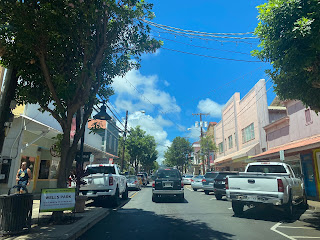The Island of Maui seemingly was not part of the original World War II era Hawaii Route System. Circa 1955 the United States Bureau of Public Roads renumbered the Hawaii Route System. The 1955 Hawaii Route Renumbering saw most of the conventions utilized by the current Hawaii State Route System established. Primary Hawaii Routes were given two-digit numbers whereas Secondary Hawaii Routes were given three-digit numbers. The Hawaii Routes were assigned in sequence for what Island/County they were located on coupled with what Federal Aid Program number they were tied to. In the case of the Island of Maui it was assigned numbers in the range of 30-40.
Hawaii Route 33 was designated as originating in Wailuku at Hawaii Route 32. Hawaii Route 33 initially followed North Market Steet and the entirety of Kahekili Highway along the northwest coast of Maui to Hawaii Route 30 at Honokohau. Hawaii Route 33 also had a bypass of downtown Wailuku which originated at Hawaii Route 32/Main Street. The Hawaii Route 33 bypass route followed Mill Street and Central Street from Hawaii Route 32 to mainline Hawaii Route 33 at North Market Street.
Hawaii Route 33 can be seen on the 1959 Gousha Highway Map of Hawaii.
During the 1960s the Hawaii Route System was simplified, and numerous minor routes were shed from the State inventory. According to hawaiihighways.com Hawaii Route 33 on North Market Street and Kahekili Highway to Waiehu Beach Road were redesignated as Maui County Route 330 during 1968. The remaining portion of Kahekili Highway was redesignated as Hawaii Route 340 to Camp Maluhia and Maui County Route 340 to Honokohau.
It is unclear when signage of North Market Street in Wailuku reverted to be signed Maui County Route 33 or if it ever was signed as Maui County Route 330. An embossed Hawaii Route 33 shield once present on North Market Street in Wailuku can be seen in Wailuku in a 2000 era image hosted by hawaiihighways.com here.
Part 2; a drive on Maui County Route 33
Wailuku is the Maui County Seat and is the longest-lived continuous community on the Island of Maui. What is now Wailuku was the site of Kamehameha's victory at the Battle of Kepaniwai during 1790. During 1860s the site of Wailuku became the hub location for the operations of the Wailuku Sugar Company. By 1905 Wailuku became the Maui County Seat and has retained it since.
Maui County Route 33 northbound begin with a left hand turn as Hawaii Route 32 eastbound on Main Street intersects North Market Street. Strangely Maui County Route 33 is adorned with newer reassurance shields on Hawaii Route 32. The Hawaii Route shield and Hawaiian County Route shields functionally are the same design. The only tangible way to know the difference between Hawaii Routes and Hawaiian County Routes is to examine the Highway Department of Transportation mileage logs (which are hosted on hawaiihighways.com)











Comments